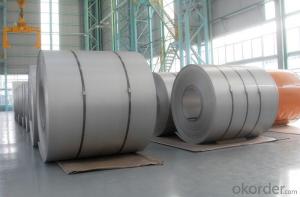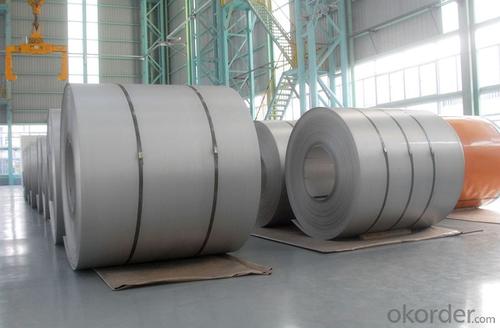430 SERIOUS COLD ROLLED STAINLESS STEEL SHEETS/COILS
- Loading Port:
- Guangzhou
- Payment Terms:
- TT OR LC
- Min Order Qty:
- 100 m.t.
- Supply Capability:
- 10000 m.t./month
OKorder Service Pledge
OKorder Financial Service
You Might Also Like
Quick Details
| Standard: | AISI,ASTM,DIN,GB,JIS | Grade: | 400 series | Thickness: | 0.25-2.0mm |
| Place of Origin: | Guangdong China (Mainland) | Brand Name: | CMAX | Model Number: | SUS430 |
| Type: | Steel Coil | Technique: | Cold Rolled | Surface Treatment: | 2B, BA, HL, NO.4 |
| Application: | Utensils, kitchenware, cutlery, pots & bowls, sinks, gas stove etc. | Width: | 800-1300mm | Length: | As requested |
| Market: | Asia, Mid East, South America etc. | Form available: | coil/ panel/ strip/ sheet | Sample: | Available |
| Packing: | PVC film with wooden pallet | Hardness: | From full hard to DDQ | Edge: | Mill edge/ Slitting edge |
| Feature: | Clean & corrosion resistance | Cr content: | 16%-18% | Steel type: | Ferrite stainless steel |
| Product name: | Cheap Cold Rolled Stainless Steel Coil 430 |
Packaging & Delivery
| Packaging Detail: | Standard export package, pvc film with wooden pallet. |
| Delivery Detail: | 15-30 days after receiving deposit |
Specifications
Cheap cold rolled stainless steel coil 430
Manufacturer
Origin: Baosteel, Tisco, Jisco
High technology & advanced equipment
Product Description
Cheap Cold Rolled Stainless Steel Coil 430 / ss430
| Item name | Cheap Cold Rolled Stainless Steel Coil 430 |
| Grade | 400 series |
| Type | Steel coil |
| Origin | CHINA |
| Standard | AISI,ASTM,DIN,GB,JIS |
| Thickness | 0.25mm-2.0mm |
| Width | 800-1300mm |
| Length | As requested |
| Surface treatment | BA, 2B, HL, No.4 |
| Edge | Mill edge/ slitting edge |
| Hardness | Full hardness to DDQ |
| Application | Utensils, kitchenware, cutlery, pots & bowls, sinks, food industry, construction decorations etc. |
| Package | Standard export package, PVC film with wooden pallet |
| Payment terms | T/T, 20% deposit in advance, balance against copy of B/L |
| Delivery time | 15-30 days after receiving the deposit |
- Q: Can stainless steel strips be used in elevator components?
- Indeed, elevator components can make use of stainless steel strips. Stainless steel is widely preferred for its long-lasting nature, ability to resist corrosion, and pleasing aesthetics, making it an ideal choice for various applications. In the context of elevator components, stainless steel strips serve multiple purposes such as cladding, adding decorative finishes, and providing structural reinforcements. These strips find applications in elevator doors, panels, frames, handrails, and other critical parts that require strength, hygiene, and the ability to withstand wear and tear. Elevator designers and builders often prioritize stainless steel strips to guarantee both durability and an appealing look.
- Q: Can stainless steel strips be used in extreme temperature conditions?
- Yes, stainless steel strips can be used in extreme temperature conditions. Stainless steel is a versatile and durable material that can withstand a wide range of temperatures. It has excellent heat resistance properties, making it suitable for use in both high and low-temperature environments. Stainless steel strips can withstand extreme heat without losing their structural integrity or mechanical properties. They are also highly resistant to thermal expansion and contraction, which ensures their stability in extreme temperature conditions. Additionally, stainless steel has good resistance to corrosion, oxidation, and scaling, which makes it an ideal choice for applications where temperature fluctuations and exposure to harsh environments are common. Overall, stainless steel strips are a reliable and efficient option for various industries that require materials capable of withstanding extreme temperature conditions.
- Q: What is the maximum temperature stainless steel strips can withstand?
- The specific grade of stainless steel being used determines the maximum temperature it can withstand. Stainless steel is generally recognized for its ability to resist high heat and can endure temperatures up to 1450°C (2642°F) without significant changes in structure or mechanical properties. However, it should be emphasized that prolonged exposure to elevated temperatures may cause oxidation and scaling on the stainless steel's surface, potentially impacting its performance. Moreover, various grades of stainless steel possess different levels of heat resistance, underscoring the importance of consulting the manufacturer's specifications or a materials engineer for precise information regarding the maximum temperature tolerance of particular stainless steel strips.
- Q: Are stainless steel strips suitable for heat exchangers?
- Yes, stainless steel strips are suitable for heat exchangers. Stainless steel has excellent corrosion resistance, high thermal conductivity, and good mechanical properties, making it a suitable material for heat exchanger applications. It can withstand high temperatures, resist scaling and oxidation, and is easy to clean, making it an ideal choice for efficient heat transfer in various industries.
- Q: How do stainless steel strips perform in abrasive environments?
- Stainless steel strips perform exceptionally well in abrasive environments due to their high resistance to corrosion, rust, and wear. The inherent properties of stainless steel, such as its chromium content, form a protective oxide layer that shields the material from abrasive elements. This enables stainless steel strips to withstand harsh conditions, maintain their strength, and retain their aesthetic appeal even in abrasive environments.
- Q: Can stainless steel strips be used for chemical processing equipment?
- Yes, stainless steel strips can be used for chemical processing equipment. Stainless steel is highly resistant to corrosion and can withstand exposure to various chemicals, making it a suitable material for manufacturing equipment used in chemical processing.
- Q: What are the mechanical properties of 111 stainless steel strips?
- The mechanical properties of 111 stainless steel strips can vary depending on factors such as the manufacturing process and specific alloy composition. However, in general, stainless steel strips with the 111 designation exhibit several key mechanical properties. 1. Tensile Strength: 111 stainless steel strips typically have a high tensile strength, which refers to the maximum amount of tensile stress that a material can withstand before failure. This property makes it suitable for applications requiring strength and resistance to deformation. 2. Yield Strength: The yield strength of 111 stainless steel strips represents the stress at which the material begins to deform permanently. It is a critical property for determining the material's ability to resist deformation under load. 3. Hardness: Stainless steel strips with the 111 designation often possess a high level of hardness, which measures the material's resistance to scratching, indentation, or penetration. This property contributes to its durability and wear resistance. 4. Ductility: Ductility refers to a material's ability to deform under tensile stress without breaking or fracturing. While stainless steel is generally known for its lower ductility compared to other metals, the specific ductility of 111 stainless steel strips can vary depending on factors such as the alloy composition and processing method. 5. Corrosion Resistance: Stainless steel, including 111 stainless steel strips, is renowned for its exceptional corrosion resistance. This property is due to the presence of chromium in the alloy, which forms a passive oxide layer that protects the material against rust and corrosion in various environments. It is important to note that these mechanical properties can vary slightly depending on the specific alloy composition, heat treatment, and manufacturing process used to produce the 111 stainless steel strips. Therefore, it is advisable to consult the manufacturer's specifications or test the material to obtain precise mechanical property data for a particular application.
- Q: Can stainless steel strips be used for magnetic applications?
- Yes, stainless steel strips can be used for magnetic applications. However, it is important to note that stainless steel itself is not a magnetic material. The magnetic properties of stainless steel strips are typically achieved by adding other elements such as nickel or manganese to the alloy. These elements help to create a magnetic structure within the stainless steel, allowing it to be attracted to magnets. It is also worth mentioning that the magnetic strength of stainless steel strips may vary depending on the specific composition of the alloy.
- Q: Are stainless steel strips available in different widths?
- Yes, stainless steel strips are available in different widths. Stainless steel strips are commonly used in various industries such as construction, automotive, and manufacturing. These strips come in a range of widths to meet different project requirements. The width options can vary from thin strips, typically around 0.5 inches or less, to wider strips that can be several inches or more in width. The availability of different widths allows for greater flexibility in designing and constructing various applications.
- Q: Can stainless steel strips be used in power generation industries?
- Yes, stainless steel strips can be used in power generation industries. Stainless steel is an alloy that offers excellent corrosion resistance and durability, making it suitable for various applications in the power generation sector. In power plants, stainless steel strips can be utilized in the construction of turbines, generators, and other equipment that come into contact with high temperatures, pressure, and corrosive environments. The corrosion-resistant properties of stainless steel ensure that these components can withstand the harsh conditions and maintain their structural integrity over time. Additionally, stainless steel strips can be used in the fabrication of heat exchangers, condensers, and various piping systems within power plants. The high thermal conductivity of stainless steel allows for efficient heat transfer, making it an ideal material for these applications. Moreover, stainless steel's resistance to oxidation and scaling at high temperatures makes it suitable for use in boilers and steam generators, which are crucial components of power generation systems. Overall, stainless steel strips offer numerous benefits such as corrosion resistance, durability, and high-temperature performance, making them a reliable choice for power generation industries.
Send your message to us
430 SERIOUS COLD ROLLED STAINLESS STEEL SHEETS/COILS
- Loading Port:
- Guangzhou
- Payment Terms:
- TT OR LC
- Min Order Qty:
- 100 m.t.
- Supply Capability:
- 10000 m.t./month
OKorder Service Pledge
OKorder Financial Service
Similar products
Hot products
Hot Searches
Related keywords



























